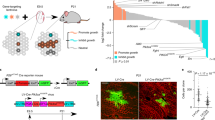Abstract
One of the major unanswered questions in carcinogenesis today concerns the rate-limiting steps that determine premalignant progression during the long latent period from the onset of carcinogen exposure until tumor appearance. Since tumor promoters apparently act to increase both the probability of occurrence and the rate of traversing events leading to malignancy, attempts to counter these promoter-induced events might offer a promising means of cancer prevention. In this connection, an understanding of the basis for resistance to tumor promoters could lead to an exploitable strategy. Our laboratory has developed the JB6 mouse epidermal cell model system for studying late-stage irreversible promotion of transformation by phorbol esters and other tumor promoters. We have recently described the isolation of promotion-resistant variants of JB6 cells which permit us to study the molecular and cellular basis for resistance (1,2). Since phorbol esters bind to specific cellular receptors and since resistance to a variety of hormones that also bind to specific receptors is associated with receptor deficiency (3), we have investigated whether the resistance of phorbol ester-resistant JB6 mouse cells can be attributed to a lack of phorbol diester receptors. This inquiry has been extended to phorbol ester-resistant variants of human hematopoietic cells.
Access this chapter
Tax calculation will be finalised at checkout
Purchases are for personal use only
Preview
Unable to display preview. Download preview PDF.
Similar content being viewed by others
References
Colburn, N.H., B. Koehler, and K.A. Nelson. 1980. A cell culture assay for tumor promoter dependent progression toward neoplastic phenotype: Detection of tumor promoters and promotion inhibitors. Teratogen. Carcinogen. Mutagen. 1: 87–96.
Colburn, N.H., E.J. Wendel, and G. Abruzzo. 1981. Dissociation of mitogenesis and late-stage promotion of tumor cell phenotype by phorbol esters: Mitogen resistant variants are sensitive to promotion. Proc. Natl. Acad. Sci. USA 78:: 6912–6916.
Pollet, R.J., and G.S. Levey. 1980. Principles of membrane receptor physiology and their application to clinical medicine. Ann. Int. Med. 92: 663–680.
Lozzio, C.B., and B.B. Lozzio. 1975. Human chronic myelogenous leukemia cell line with positive Philadelphia chromosome. Blood 45: 321–334.
Collins, S.J., R.C. Gallo, and R.E. Gallagher. 1977. Continuous growth and differentiation of human myeloid leukemic cells in a suspension culture. Nature (London) 270: 347–349.
Pruss, R.M., and H.R. Herschman. 1977. Variants of 3T3 cells lacking mitogenic response to epidermal growth factor. Proc. Natl. Acad. Sci. USA 74: 3918–3921.
Colburn, N.H., W.F. Vorderbruegge, J.R. Bates, R.H. Gray, J.D. Rossen, W.H. Kelsey, and T. Shimada. 1978. Correlation of anchorage-independent growth with tumorigenicity of chemically transformed mouse epidermal cells. Cancer Res. 38: 624–634.
Colburn, N.H., B.F. Former, K.A. Nelson, and S.H. Yuspa. 1979. Tumor promoter induces anchorage independence irreversibly. Nature 281: 589–591.
Knott, G.D., and D.K. Reece. 1972. M-LAB: A civilized curve-fitting system. Proc. Int. Conf. on Online Interactive Computing, Vol 1. Online Computer Systems, Oxbridge, England. pp. 497–526.
Solanki, T.J., M. Slaga, R. Callahan, and E. Huberman. 1981. Down regulation of specific binding of [20–3H]phorbol 12,13-dibutyrate and phorbol ester induced differentiation of human promyelocytic leukemia cells. Proc. Natl. Acad. Sci. USA 78: 1722–1725.
Colburn, N.H., T.D. Gindhart, G.A. Hegamyer, P.M. Blumberg, B. Delclos, B.E. Magun, and J. Lockyer. (in press). The role of phorbol diester and EGF receptors in determining sensitivity to TPA. Cancer Res.
Driedger, P.E., and P.M. Blumberg. 1980. Specific binding of phorbol ester tumor promoters. Proc. Natl. Acad. Sci. USA 77: 567–571.
Dunphy, W.G., K.B. Delclos, and P.M. Blumberg. 1980. Characterization of specific binding of [3H]phorbol 12,13-dibutyrate and [3H]phorbol-12-myristate 13-acetate to mouse brain. Cancer Res. 40: 3635–3641.
Delclos, K.B., D.S. Nagle, and P.M. Blumberg. 1980. Specific binding of phorbol ester tumor promoters to mouse skin. Cell 19: 1025–1032.
Fisher, P.B., H. Cogan, A.D. Horowitz, D. Schachter, and I.B. Weinstein. 1981. TPA resistance in Friend erythroleukemia cells: Role of membrane lipid fluidity. Biochem. Biophys. Res. Comm. 100: 370–376.
Mendelsohn, N., H.S. Gilbert, J.K. Christman, and G. Acs. 1980. Effect of maturation on the response of human promyelocytic leukemia cells (HL-60) to the tumor promoter 12–0-tetradecanoylphorbol-13-acetate. Cancer Res. 40: 1469–1474.
Horowitz, A.D., E. Greenbaum, and I.B. Weinstein. 1981. Identification of receptors for phorbol ester tumor promoters in intact mammalian cells and of an inhibitor of receptor binding in biologic fluids. Proc. Natl. Acad. Sci. USA 78: 2315–2319.
Seaman, W.S., T.D. Gindhart, M.A. Blackman, B. Dalal, N. Talal, and Z. Werb. 1981. Natural killing of tumor cells by human peripheral blood cells: Suppression of killing in vitro by tumor promoting phorbol diesters. J. Clin. Invest. 67: 1324–1333.
Kensler, J.W., and M.A. Trush. 1981. Inhibition of phorbol ester-stimulated chemiluminescence in human polymorphonuclear leukocytes by retinoic acid and 5,6-epoxyretinoic acid. Cancer Res. 41: 216–222.
Author information
Authors and Affiliations
Editor information
Editors and Affiliations
Rights and permissions
Copyright information
© 1983 Plenum Press, New York
About this chapter
Cite this chapter
Colburn, N.H., Gindhart, T.D., Dalal, B., Hegamyer, G.A. (1983). The Role of Phorbol Ester Receptor Binding in Responses to Promoters by Mouse and Human Cells. In: Langenbach, R., Nesnow, S., Rice, J.M. (eds) Organ and Species Specificity in Chemical Carcinogenesis. Basic Life Sciences. Springer, Boston, MA. https://doi.org/10.1007/978-1-4684-4400-1_10
Download citation
DOI: https://doi.org/10.1007/978-1-4684-4400-1_10
Publisher Name: Springer, Boston, MA
Print ISBN: 978-1-4684-4402-5
Online ISBN: 978-1-4684-4400-1
eBook Packages: Springer Book Archive




